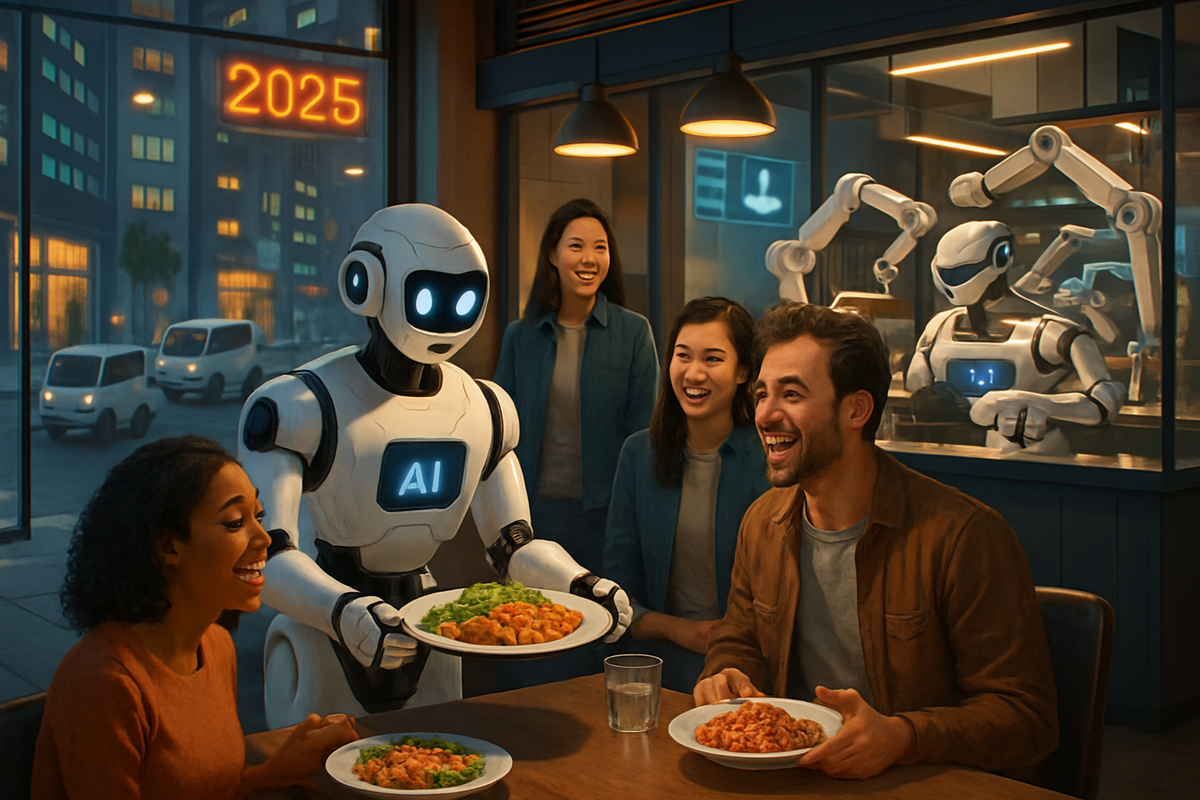Robot Restaurant Revolution 2025: How AI-Powered Bots Are Reshaping Dining, Delivery, and Hospitality
Explore the sizzling future of dining where robots redefine hospitality with AI precision, enhancing speed, novelty, and sustainability while transforming the restaurant industry into a $10 billion market by 2030.

Welcome to the Era of Robo-Dining
Imagine this: You order a burger on your phone, and 20 minutes later, a bright-eyed robot rolls up to your door, burger in belly, ready to greet you with a digital grin. Inside your favorite eatery, a robot chef flips patties with algorithmic precision, while a robotic server glides by, expertly dodging toddlers and spilled ketchup. No, you haven’t stumbled into a sci-fi movie—it’s 2025, and the robot restaurant revolution is sizzling hot, serving up a fresh new future for dining, delivery, and hospitality.
Why Robots? The Perfect Storm for Automation
The recipe for this revolution? A generous helping of labor shortages, a dash of rising food costs, and a heaping spoonful of consumer demand for speed and novelty. According to industry reports, over 70% of restaurant operators have upped their tech budgets to embrace automation, with AI-powered robots leading the charge. The market for smart restaurant robotics is expected to exceed $10 billion by 2030—and that’s not just hype, it’s hot-off-the-grill reality.
Meet the Cast: Delivery Bots, Robo-Chefs, and More
1. Delivery Bots: Taking Over the Sidewalks
- Coco Robotics is rolling out 10,000 AI-powered food delivery robots across Los Angeles in the next year, offering a quirky, zero-emissions alternative to human couriers. These bots brave curbs and crossings, occasionally causing traffic jams (and the odd viral video).
- Serve Robotics has partnered with Shake Shack and Uber Eats, aiming to deploy up to 2,000 sidewalk robots in U.S. cities. Their bots can carry multiple pizzas, navigate tough terrain, and operate all day on a single charge.
- Avride bots, now cruising in Jersey City and Dallas, carry up to 55 pounds and keep meals warm in temperature-controlled compartments—because nobody likes cold fries, not even robots.
2. Robo-Chefs, Waiters, and Baristas: Inside the Restaurant
- Miso Robotics’ Flippy is the fry cook of the future, whipping up fries, onion rings, and even tacos at twice the speed of human hands. White Castle, Jack in the Box, and Dodger Stadium are already fans.
- Bear Robotics and LG Electronics are bringing robot waiters to busy dining rooms, serving up orders with multi-tray arms and obstacle-avoiding smarts.
- Richtech Robotics’ Adam is a barista and bartender in Las Vegas, pouring perfect boba teas and coffee drinks thousands of times a month—with zero risk of calling in sick.
The Tech Behind the Taste: How AI and Robotics Are Changing the Game
Today’s restaurant robots aren’t just cute faces on wheels—they’re powered by advanced AI and a buffet of sensors, from LiDAR and cameras to ultrasonic detectors. These bots:
- Navigate complex indoor and outdoor environments
- Optimize delivery routes and predict arrival times
- Personalize recommendations and upsell menu items
- Automate cooking, cleaning, and administrative tasks
“The smart restaurant robot industry is expected to exceed $10 billion by 2030, driven by deployment across delivery, order-taking, and table service.”
— Archive Market Research, 2025
Who’s Winning? Real-World Impact and Consumer Buzz
For Restaurants:
- Lower labor costs and more consistent service, even during peak hours.
- Novelty factor attracts curious diners (and their Instagram feeds).
- AI-driven analytics reduce food waste and help optimize menus.
For Diners:
- Faster, more reliable service—and a dash of futuristic fun.
- Personalized menu suggestions powered by AI.
- Contactless, hygienic delivery (and a great story to tell at brunch).
For Workers:
- Some fear job losses, but many restaurants are re-skilling staff for higher-value roles—think tech maintenance and customer experience.
- AI is also tackling administrative headaches, freeing up humans for creativity and hospitality.
“Robots are cooking, serving, and delivering in restaurants, helping with labor shortages and rising food costs.”
— PYMNTS, 2025
The Flip Side: Glitches, Grumbles, and Growing Pains
Of course, no revolution is without its hiccups. Some L.A. residents have discovered that when a delivery bot “glitches out” in the middle of an intersection, it’s less Wall-E and more Wreck-It Ralph. And while robots don’t need breaks, they do need recharging—and the occasional firmware update.
Consumer reactions range from delighted to dubious. Some see robots as the future; others miss the human touch. The ongoing challenge? Balancing automation with authentic hospitality.
What’s Next? The Future of Dining, Delivered
- Hyper-personalized dining: AI will tailor menus and experiences to your preferences and health goals.
- Robot-human collaboration: Think robots handling the grunt work, humans focusing on creativity, service, and delight.
- Smarter, greener logistics: Autonomous fleets reduce emissions and food waste, making urban dining more sustainable.
- New jobs, new skills: From robot wranglers to AI sommeliers, tomorrow’s restaurant workforce will be part engineer, part entertainer.
One thing’s for sure: The way we eat, work, and connect around food is being reimagined—one algorithm at a time.
Hungry for More? Join the Insider Table
If you’re fascinated by the future of food, tech, and the quirky world of robo-dining, don’t just lurk on the sidelines. Subscribe as a Funaix Insider at this link for smart news, exclusive deep-dives, and perks delivered straight to your (non-robotic) inbox. You’ll be the first to know about the latest trends, tech reviews, and maybe even a few robot blooper reels.
Published on August 1, 2025.
Sources: Axios, Reuters, Forbes, PYMNTS, Host Merchant Services, Archive Market Research.




